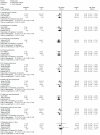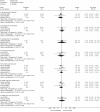Intravenous pantoprazole as an adjuvant therapy following successful endoscopic treatment for peptic ulcer bleeding
- PMID: 19373423
- PMCID: PMC2711680
- DOI: 10.1155/2009/191706
Intravenous pantoprazole as an adjuvant therapy following successful endoscopic treatment for peptic ulcer bleeding
Abstract
Background: Several studies have suggested that proton pump inhibitors are efficacious in preventing rebleeding when administered immediately after endoscopic treatments. However, there are limited clinical outcome data on the use of intravenous pantoprazole.
Objective: To evaluate the efficacy of intravenous pantoprazole after successful endoscopic treatment for peptic ulcer bleeding using evidence from randomized controlled trials (RCTs).
Methods: The Cochrane Library, MEDLINE, EMBASE and several Chinese databases up to July 2008 were searched. RCTs that compared the relative effectiveness of intravenous pantoprazole with placebo, H2 receptor antagonist or other agents for patients with peptic ulcer bleeding who were pretreated with successful endoscopic therapies were retrieved.
Results: Five RCTs comprising a total of 821 participants were included in the final meta-analysis. Overall, there were significant differences in ulcer rebleeding (RR 0.31; 95% CI 0.18 to 0.53; pooled rates were 4.7% for pantoprazole and 15.0% for control), surgical intervention (RR 0.28, 95% CI 0.09 to 0.83; pooled rates were 1.4% in pantoprazole group versus 6.5% in control) and total length of hospital stay (weighted mean difference -1.53; 95% CI -1.91 to -1.16), but not on mortality (RR 0.72, 95% CI 0.29 to 1.81; pooled mortality rates were 1.9% for pantoprazole versus 2.8% for control) and blood transfusion requirements (weighted mean difference -0.53; 95% CI for random effects -1.04 to -0.02) when compared with control treatments. A series of subgroup analyses supported the results from the main analysis.
Conclusions: Intravenous administration of pantoprazole after endoscopic therapy for peptic ulcer bleeding reduces rates of ulcer rebleeding, surgical intervention and overall duration of hospital stay, but not mortality and blood transfusion requirements compared with placebo, H2 receptor antagonist or somatostatin.
HISTORIQUE :: Plusieurs études laissent supposer que les inhibiteurs de la pompe à protons sont efficaces pour prévenir des récidives d’hémorragie s’ils sont administrés immédiatement après les traitements endoscopiques. Cependant, on possède peu de données d’issues cliniques sur l’utilisation du pantoprazole par intraveineuse (IV).
OBJECTIF :: Évaluer l’efficacité du pantoprazole IV après le traitement endoscopique réussi de l’hémorragie d’un ulcère gastroduodénal au moyen de données probantes tirées d’essais aléatoires et contrôlés (EAC).
MÉTHODOLOGIE :: Les auteurs ont fait des recherches dans la Bibliothèque Cochrane, MEDLINE, EMBASE et plusieurs bases de données chinoises jusqu’à juillet 2008. Ils ont extrait les EAC dans lesquels on comparait l’efficacité relative du pantoprazole IV à un placebo, à un antagoniste des récepteurs H2 ou à d’autres agents chez des patients souffrant d’hémorragie attribuable à un ulcère gastroduodénal ayant déjà été traités avec succès par endoscopie.
RÉSULTATS :: La méta-analyse finale incluait cinq EAC, pour un total de 821 participants. Dans l’ensemble, par rapport aux sujets témoins, on constatait une différence significative pour ce qui est des récidives d’hémorragie de l’ulcère (RRR 0,31; 95 % IC 0,18 à 0,53; les taux regroupés s’élevaient à 4,7 % dans le groupe prenant du pantoprazole et à 15,0 % dans le groupe témoin), des interventions chirurgicales (RRR 0,28; 95 % IC 0,09 à 0,83; les taux regroupés s’élevaient à 1,4 % dans le groupe prenant du pantoprazole et à 6,5 % dans le groupe témoin) et de l’hospitalisation totale (différence moyenne pondérée −1,53; 95 % IC −1,91 à −1,16), mais non pour ce qui est de la mortalité (RRR 0,72; 95 % IC 0,29 à 1,81; les taux de mortalité regroupés s’élevaient à 1,9 % dans le groupe prenant du pantoprazole et à 2,8 % dans le groupe témoin) et des besoins de transfusion sanguine (différence moyenne pondérée −0,53; 95 % IC pour les effets aléatoires −1,04 à −0,02). Une série d’analyses de sous-groupes a corroboré les résultats de l’analyse principale.
CONCLUSIONS :: L’administration de pantoprazole IV après le traitement endoscopique de l’hémorragie d’un ulcère gastroduodénal réduit les taux de récidive d’hémorragie de l’ulcère, d’intervention chirurgicale et la durée des hospitalisations, mais non la mortalité et les besoins de transfusion sanguine par rapport à un placebo, à un antagoniste des récepteurs H2 ou à la somostatine.
Figures











Similar articles
-
Pantoprazole infusion as adjuvant therapy to endoscopic treatment in patients with peptic ulcer bleeding: prospective randomized controlled trial.J Gastroenterol Hepatol. 2006 Apr;21(4):716-21. doi: 10.1111/j.1440-1746.2006.04292.x. J Gastroenterol Hepatol. 2006. PMID: 16677158 Clinical Trial.
-
Intermittent versus continuous pantoprazole infusion in peptic ulcer bleeding: a prospective randomized study.Digestion. 2008;78(1):39-43. doi: 10.1159/000158227. Epub 2008 Sep 29. Digestion. 2008. PMID: 18824852 Clinical Trial.
-
Oral versus intravenous proton pump inhibitors in preventing re-bleeding for patients with peptic ulcer bleeding after successful endoscopic therapy.BMC Gastroenterol. 2012 Jun 8;12:66. doi: 10.1186/1471-230X-12-66. BMC Gastroenterol. 2012. PMID: 22681960 Free PMC article. Clinical Trial.
-
High-dose vs. Low-dose Proton Pump Inhibitors post-endoscopic hemostasis in patients with bleeding peptic ulcer. A meta-analysis and meta-regression analysis.Turk J Gastroenterol. 2018 Jan;29(1):22-31. doi: 10.5152/tjg.2018.17143. Turk J Gastroenterol. 2018. PMID: 29391304 Free PMC article.
-
Oral Proton Pump Inhibitors May Be as Effective as Intravenous in Peptic Ulcer Bleeding: A Systematic Review and Meta-analysis.Clin Transl Gastroenterol. 2021 Apr 14;12(4):e00341. doi: 10.14309/ctg.0000000000000341. Clin Transl Gastroenterol. 2021. PMID: 33988530 Free PMC article.
Cited by
-
The effect of pantoprazole and somatostatin combined with thrombin in the treatment of non-esophagogastric varicosity upper gastrointestinal bleeding.Am J Transl Res. 2021 May 15;13(5):5484-5490. eCollection 2021. Am J Transl Res. 2021. PMID: 34150147 Free PMC article.
-
High Dose versus Low Dose Intravenous Pantoprazole in Bleeding Peptic Ulcer: A Randomized Clinical Trial.Middle East J Dig Dis. 2014 Jul;6(3):137-43. Middle East J Dig Dis. 2014. PMID: 25093061 Free PMC article.
-
Evidence-based clinical practice guidelines for peptic ulcer disease 2020.J Gastroenterol. 2021 Apr;56(4):303-322. doi: 10.1007/s00535-021-01769-0. Epub 2021 Feb 23. J Gastroenterol. 2021. PMID: 33620586 Free PMC article.
-
Pharmacokinetics, Pharmacodynamics and Safety of Multiple-Infusion Ilaprazole in Healthy Chinese Subjects.Clin Drug Investig. 2016 Jun;36(6):463-70. doi: 10.1007/s40261-016-0390-2. Clin Drug Investig. 2016. PMID: 27067231
-
Gastric acid inhibition in the treatment of peptic ulcer hemorrhage.Curr Gastroenterol Rep. 2009 Dec;11(6):462-9. doi: 10.1007/s11894-009-0071-x. Curr Gastroenterol Rep. 2009. PMID: 19903422 Review.
References
-
- Saltzman JR, Zawacki JK. Therapy for bleeding peptic ulcers. N Engl J Med. 1997;336:1091–3. - PubMed
-
- Selby NM, Kubba AK, Hawkey CJ. Acid suppression in peptic ulcer haemorrhage: A ‘meta-analysis’. Aliment Pharmacol Ther. 2000;14:1119–26. - PubMed
-
- Paimela H, Paimela L, Myllykangas-Luosujärvi R, et al. Current features of peptic ulcer disease in Finland: Incidence of surgery, hospital admissions and mortality for the disease during the past twenty-five years. Scand J Gastroenterol. 2002;37:399–403. - PubMed
-
- van Leerdam ME, Vreeburg EM, Rauws EA, et al. Acute upper GI bleeding: Did anything change? Time trend analysis of incidence and outcome of acute upper GI bleeding between 1993/1994 and 2000. Am J Gastroenterol. 2003;98:1494–9. - PubMed
Publication types
MeSH terms
Substances
LinkOut - more resources
Full Text Sources
